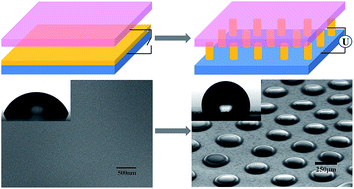Preparation, properties, and efficient electrically induced structure formation of a leaky dielectric photoresist
Abstract
A leaky dielectric photoresist was designed and prepared by doping a soluble conductive polypyrrole into a low-viscosity photocurable resin (perfect dielectric) to achieve efficient electrically induced structure formation (EISF). The comprehensive properties of both the leaky dielectric photoresist and its cured film were systematically investigated. It was found that the leaky dielectric photoresist is homogeneous and stable in both the liquid state and solid state after curing, as a result of the low molecular weight and the bulky side groups of polypyrrole. The leaky dielectric photoresist retains the Newtonian nature of the photocurable resin with low viscosity, displays a significant increase in the electrical conductivity with an increase in the polypyrrole loading, and shows favorable wettability on a silicon substrate. Meanwhile, the cured film is still transparent, thermally stable and featureless, following the increase in the polypyrrole loading. It is worth noting that by using a low-viscosity leaky dielectric photoresist, pillar arrays can be rapidly fabricated over large areas at ambient temperature via EISF onto a featureless template. The resulting patterned film is hydrophobic with an apparent contact angle of 109°, even though the cured film is hydrophilic with an intrinsic contact angle of 64°.



 Please wait while we load your content...
Please wait while we load your content...